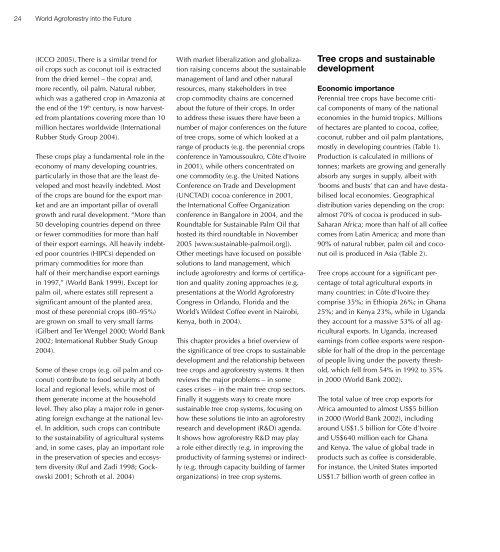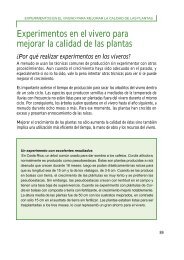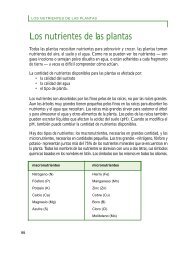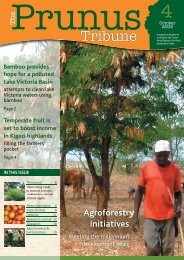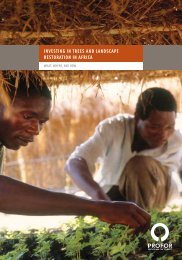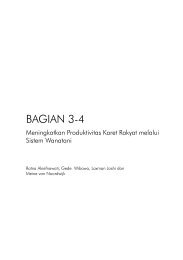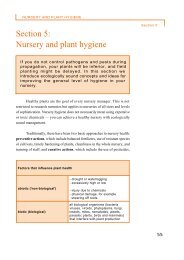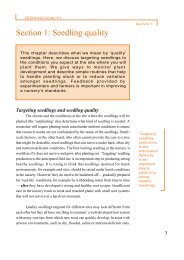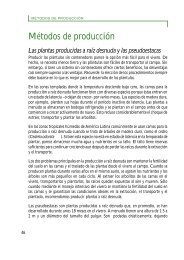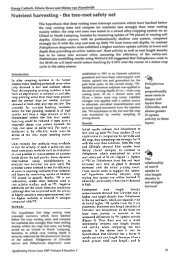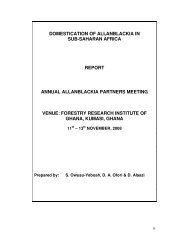Download as a PDF - World Agroforestry Centre
Download as a PDF - World Agroforestry Centre
Download as a PDF - World Agroforestry Centre
Create successful ePaper yourself
Turn your PDF publications into a flip-book with our unique Google optimized e-Paper software.
24<br />
<strong>World</strong> <strong>Agroforestry</strong> into the Future<br />
(ICCO 2005). There is a similar trend for<br />
oil crops such <strong>as</strong> coconut (oil is extracted<br />
from the dried kernel – the copra) and,<br />
more recently, oil palm. Natural rubber,<br />
which w<strong>as</strong> a gathered crop in Amazonia at<br />
the end of the 19 th century, is now harvested<br />
from plantations covering more than 10<br />
million hectares worldwide (International<br />
Rubber Study Group 2004).<br />
These crops play a fundamental role in the<br />
economy of many developing countries,<br />
particularly in those that are the le<strong>as</strong>t developed<br />
and most heavily indebted. Most<br />
of the crops are bound for the export market<br />
and are an important pillar of overall<br />
growth and rural development. “More than<br />
50 developing countries depend on three<br />
or fewer commodities for more than half<br />
of their export earnings. All heavily indebted<br />
poor countries (HIPCs) depended on<br />
primary commodities for more than<br />
half of their merchandise export earnings<br />
in 1997,” (<strong>World</strong> Bank 1999). Except for<br />
palm oil, where estates still represent a<br />
significant amount of the planted area,<br />
most of these perennial crops (80–95%)<br />
are grown on small to very small farms<br />
(Gilbert and Ter Wengel 2000; <strong>World</strong> Bank<br />
2002; International Rubber Study Group<br />
2004).<br />
Some of these crops (e.g. oil palm and coconut)<br />
contribute to food security at both<br />
local and regional levels, while most of<br />
them generate income at the household<br />
level. They also play a major role in generating<br />
foreign exchange at the national level.<br />
In addition, such crops can contribute<br />
to the sustainability of agricultural systems<br />
and, in some c<strong>as</strong>es, play an important role<br />
in the preservation of species and ecosystem<br />
diversity (Ruf and Zadi 1998; Gockowski<br />
2001; Schroth et al. 2004)<br />
With market liberalization and globalization<br />
raising concerns about the sustainable<br />
management of land and other natural<br />
resources, many stakeholders in tree<br />
crop commodity chains are concerned<br />
about the future of their crops. In order<br />
to address these issues there have been a<br />
number of major conferences on the future<br />
of tree crops, some of which looked at a<br />
range of products (e.g. the perennial crops<br />
conference in Yamoussoukro, Côte d’Ivoire<br />
in 2001), while others concentrated on<br />
one commodity (e.g. the United Nations<br />
Conference on Trade and Development<br />
(UNCTAD) cocoa conference in 2001,<br />
the International Coffee Organization<br />
conference in Bangalore in 2004, and the<br />
Roundtable for Sustainable Palm Oil that<br />
hosted its third roundtable in November<br />
2005 [www.sustainable-palmoil.org]).<br />
Other meetings have focused on possible<br />
solutions to land management, which<br />
include agroforestry and forms of certification<br />
and quality zoning approaches (e.g.<br />
presentations at the <strong>World</strong> <strong>Agroforestry</strong><br />
Congress in Orlando, Florida and the<br />
<strong>World</strong>’s Wildest Coffee event in Nairobi,<br />
Kenya, both in 2004).<br />
This chapter provides a brief overview of<br />
the significance of tree crops to sustainable<br />
development and the relationship between<br />
tree crops and agroforestry systems. It then<br />
reviews the major problems – in some<br />
c<strong>as</strong>es crises – in the main tree crop sectors.<br />
Finally it suggests ways to create more<br />
sustainable tree crop systems, focusing on<br />
how these solutions tie into an agroforestry<br />
research and development (R&D) agenda.<br />
It shows how agroforestry R&D may play<br />
a role either directly (e.g. in improving the<br />
productivity of farming systems) or indirectly<br />
(e.g. through capacity building of farmer<br />
organizations) in tree crop systems.<br />
Tree crops and sustainable<br />
development<br />
Economic importance<br />
Perennial tree crops have become critical<br />
components of many of the national<br />
economies in the humid tropics. Millions<br />
of hectares are planted to cocoa, coffee,<br />
coconut, rubber and oil palm plantations,<br />
mostly in developing countries (Table 1).<br />
Production is calculated in millions of<br />
tonnes; markets are growing and generally<br />
absorb any surges in supply, albeit with<br />
‘booms and busts’ that can and have destabilised<br />
local economies. Geographical<br />
distribution varies depending on the crop:<br />
almost 70% of cocoa is produced in sub-<br />
Saharan Africa; more than half of all coffee<br />
comes from Latin America; and more than<br />
90% of natural rubber, palm oil and coconut<br />
oil is produced in Asia (Table 2).<br />
Tree crops account for a significant percentage<br />
of total agricultural exports in<br />
many countries: in Côte d’Ivoire they<br />
comprise 35%; in Ethiopia 26%; in Ghana<br />
25%; and in Kenya 23%, while in Uganda<br />
they account for a m<strong>as</strong>sive 53% of all agricultural<br />
exports. In Uganda, incre<strong>as</strong>ed<br />
earnings from coffee exports were responsible<br />
for half of the drop in the percentage<br />
of people living under the poverty threshold,<br />
which fell from 54% in 1992 to 35%<br />
in 2000 (<strong>World</strong> Bank 2002).<br />
The total value of tree crop exports for<br />
Africa amounted to almost US$5 billion<br />
in 2000 (<strong>World</strong> Bank 2002), including<br />
around US$1.5 billion for Côte d’Ivoire<br />
and US$640 million each for Ghana<br />
and Kenya. The value of global trade in<br />
products such <strong>as</strong> coffee is considerable.<br />
For instance, the United States imported<br />
US$1.7 billion worth of green coffee in


